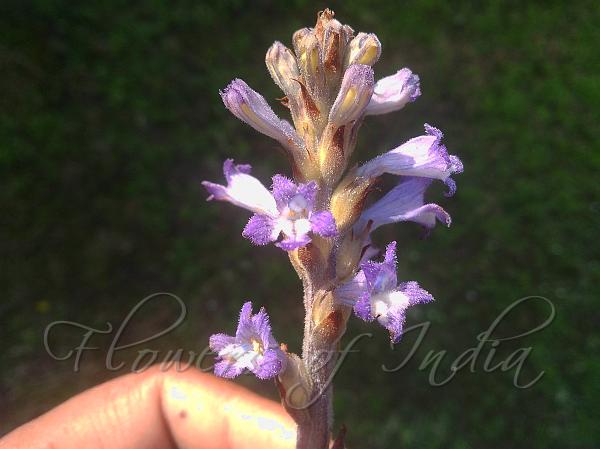|
| Egyptian Broomrape |
|

|

| File size | 666824 |
| Original date | 1/23/21 12:39 PM |
| Resolution | 3000 x 4000 |
| Flash | Flash did not fire, auto |
| Focal length | 3.819mm |
| Exposure time | 1/411s |
| Aperture | 2.2 |
| Focus Distance | |
| Metering Mode | Center weighted average |
| Camera make | Xiaomi |
| Camera model | Redmi Note 5 |
| Sensor type | OneChipColorArea |
|
|
|
|
Photo: |
Botanical name: Orobanche aegyptiaca Family: Orobanchaceae (Broomrape family)
Synonyms: Orobanche indica, Orobanche longiflora, Orobanche aemula
Synonyms: Orobanche indica, Orobanche longiflora, Orobanche aemula
Egyptian Broomrape is a root parasite, and an annual
herb, 15-50 cm tall, glandular velvet-hairy. Stems are branched above
middle. Leaves are ovate-lanceshaped, 8-10 x 2-4 mm, along with bracts,
bractlets, sepal-cup, and flower densely glandular velvet-hairy below.
Flowers are borne in spikes, 8-15 cm long, bract ovate-lanceshaped or
lanceshaped, 6-10 x 3-4 mm; bractlets linear, 6-10 mm. Flowers are
nearly stalkless, blue-purple, 2-3.5 cm, tube about 2 cm; upper lip
2-lobed; lower lip longer than upper; lobes entire, white hairy at
margin. Pistil is 2.2-2.6 cm, style 1.8-2 cm, glandular velvet-hairy;
stigma 2-lobed. Sepal-cup is bell-shaped, 1-1.4 cm, 4- or 5-lobed to
middle; sepals linear-lanceshaped, 4-7 mm. Capsule is oblong, 0.8-1.2
cm x about 6 mm. Egyptian Broomrape is found in SE Europe to Central
Asia and Indian Subcontinent, Himalayas, N. Africa to Sahara, at
altitudes of 150-3100 m. Flowering: April-June.
| Identification credit: Dipankar Borah | Photographed in Monabarie Tea Estate, Sonitpur, Assam. |
• Is this flower misidentified? If yes,